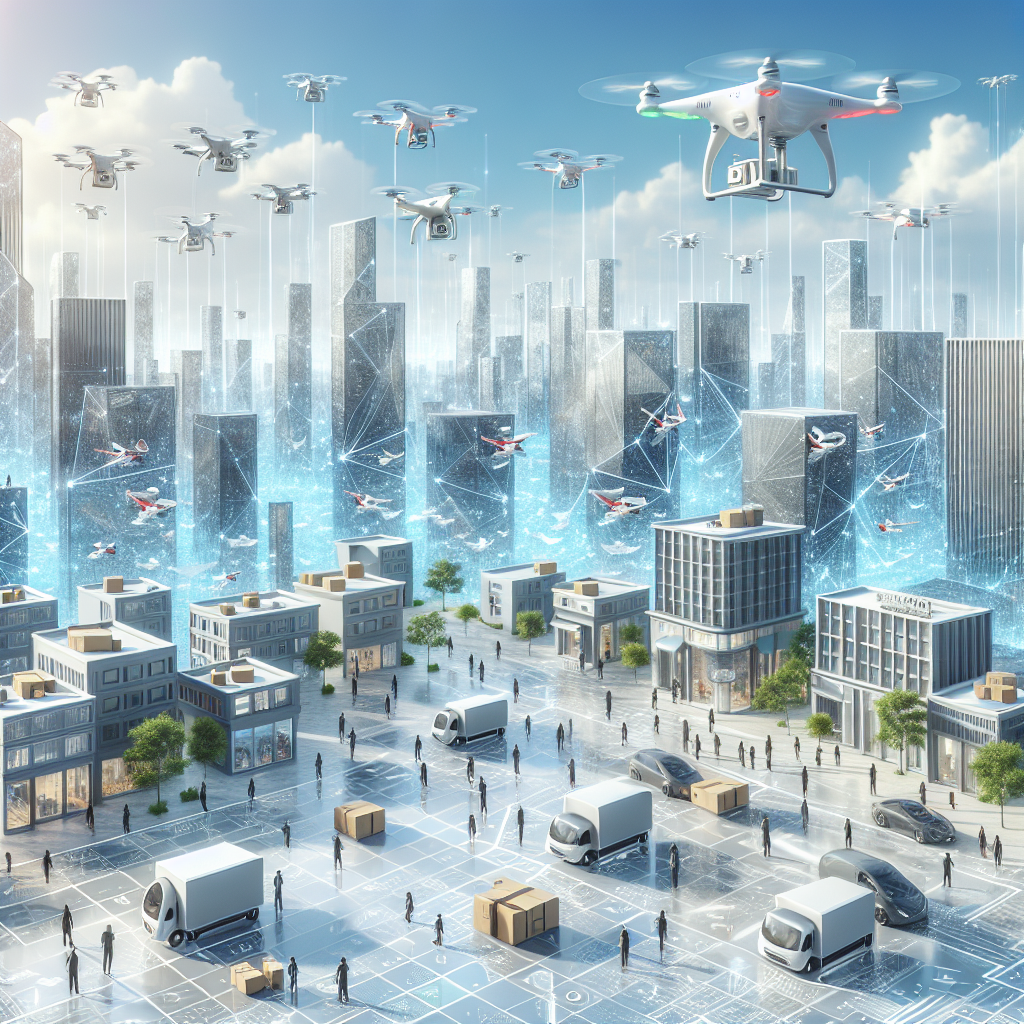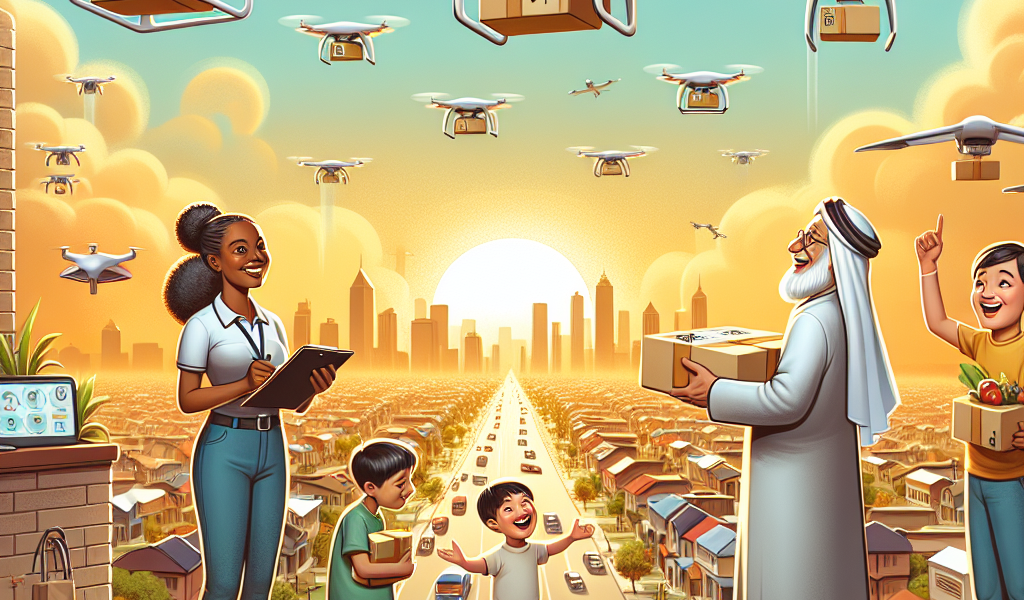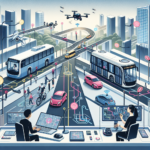-
Table of Contents
“Redefining Speed and Efficiency: Autonomous Drones Deliver the Future Today”
Introduction

Autonomous drones are revolutionizing delivery services by offering unprecedented speed, efficiency, and cost-effectiveness. These unmanned aerial vehicles (UAVs) are equipped with advanced navigation systems, artificial intelligence, and machine learning algorithms, enabling them to operate without human intervention. They can deliver packages to remote or hard-to-reach areas, reducing delivery times from days to mere hours. Additionally, autonomous drones minimize the need for ground transportation, thereby decreasing traffic congestion and lowering carbon emissions. Companies across various industries, from retail to healthcare, are increasingly adopting drone technology to enhance their logistics and supply chain operations, ultimately transforming the landscape of delivery services.
Enhancing Efficiency: The Role of Autonomous Drones in Streamlining Delivery Services
Autonomous drones are rapidly transforming the landscape of delivery services, offering a glimpse into a future where efficiency and speed are paramount. As technology continues to advance, these flying robots are becoming more sophisticated, capable of navigating complex environments and delivering packages with unprecedented precision. This evolution is not just a technological marvel but a practical solution to many logistical challenges faced by traditional delivery methods.
One of the most significant advantages of autonomous drones is their ability to bypass traffic congestion, a perennial problem in urban areas. Unlike delivery trucks that are often stuck in gridlock, drones can take to the skies, ensuring that packages reach their destinations in a fraction of the time. This capability is particularly beneficial for time-sensitive deliveries, such as medical supplies or perishable goods, where every minute counts. By reducing delivery times, drones are not only enhancing efficiency but also improving customer satisfaction.
Moreover, the use of autonomous drones in delivery services is contributing to a reduction in carbon emissions. Traditional delivery vehicles, especially those powered by fossil fuels, are significant contributors to air pollution. In contrast, drones are typically electric-powered, making them a more environmentally friendly option. This shift towards greener delivery methods aligns with the growing global emphasis on sustainability and the need to reduce our carbon footprint.
In addition to environmental benefits, autonomous drones are also proving to be cost-effective. The initial investment in drone technology may be high, but the long-term savings are substantial. Drones require less maintenance compared to traditional vehicles and eliminate the need for drivers, thereby reducing labor costs. Furthermore, their ability to operate autonomously means that they can work around the clock, increasing the volume of deliveries without the constraints of human working hours.
The integration of advanced technologies such as artificial intelligence and machine learning is further enhancing the capabilities of autonomous drones. These technologies enable drones to learn from their experiences, improving their navigation and decision-making skills over time. For instance, AI algorithms can help drones identify the most efficient routes, avoid obstacles, and even predict potential issues before they arise. This continuous learning process ensures that drones become more reliable and efficient with each delivery.
However, the widespread adoption of autonomous drones in delivery services is not without its challenges. Regulatory hurdles remain a significant barrier, as governments around the world grapple with the need to ensure safety and privacy while fostering innovation. Airspace regulations, in particular, are a complex issue, as authorities must balance the integration of drones with existing air traffic. Despite these challenges, progress is being made, with several countries already implementing pilot programs to test the feasibility of drone deliveries.
Public perception is another critical factor that will influence the future of autonomous drone deliveries. While many people are excited about the prospect of faster and more efficient deliveries, concerns about privacy and security cannot be ignored. Companies deploying drone technology must address these concerns transparently, ensuring that robust measures are in place to protect personal data and prevent unauthorized access.
In conclusion, autonomous drones are poised to revolutionize delivery services by enhancing efficiency, reducing environmental impact, and cutting costs. As technology continues to evolve and regulatory frameworks adapt, the sky is quite literally the limit for what these flying robots can achieve. With the potential to transform not just delivery services but the entire logistics industry, autonomous drones represent a significant step forward in our quest for a more efficient and sustainable future.
Safety and Precision: How Autonomous Drones are Redefining Delivery Accuracy
Autonomous drones are rapidly transforming the landscape of delivery services, bringing a new level of safety and precision that was previously unimaginable. As these high-tech devices take to the skies, they are redefining delivery accuracy in ways that benefit both businesses and consumers alike. The integration of advanced technologies such as artificial intelligence, machine learning, and GPS navigation has enabled drones to perform tasks with remarkable efficiency and reliability.
One of the most significant advantages of autonomous drones is their ability to navigate complex environments with ease. Equipped with sophisticated sensors and real-time data processing capabilities, these drones can detect and avoid obstacles, ensuring that packages are delivered safely and intact. This level of precision is particularly crucial in urban areas, where the risk of collisions with buildings, trees, and other structures is high. By leveraging cutting-edge technology, drones can plot optimal flight paths, minimizing the chances of accidents and enhancing overall delivery accuracy.
Moreover, the use of autonomous drones in delivery services has led to a substantial reduction in human error. Traditional delivery methods often rely on manual labor, which can be prone to mistakes such as incorrect addresses, misplaced packages, or delays due to traffic congestion. In contrast, drones operate based on pre-programmed instructions and real-time data, significantly reducing the likelihood of errors. This not only ensures that packages reach their intended destinations promptly but also enhances customer satisfaction by providing a more reliable service.
In addition to improving accuracy, autonomous drones also offer a safer alternative to conventional delivery methods. For instance, in remote or hazardous areas where human delivery personnel might face risks, drones can perform deliveries without putting anyone in harm’s way. This capability is particularly valuable in emergency situations, such as delivering medical supplies to disaster-stricken regions or transporting essential goods during a pandemic. By eliminating the need for human intervention in dangerous scenarios, drones contribute to a safer and more efficient delivery process.
Furthermore, the environmental benefits of using autonomous drones for deliveries cannot be overlooked. Traditional delivery vehicles, such as trucks and vans, contribute to traffic congestion and air pollution. Drones, on the other hand, are typically powered by electric batteries, resulting in lower carbon emissions and a smaller environmental footprint. As the world grapples with the challenges of climate change, the adoption of eco-friendly delivery solutions like drones becomes increasingly important.
The precision and safety offered by autonomous drones are also driving innovation in various industries. For example, in the healthcare sector, drones are being used to transport medical samples, vaccines, and even organs for transplantation. The ability to deliver these critical items quickly and accurately can save lives and improve patient outcomes. Similarly, in the retail industry, companies are exploring the use of drones to provide same-day or even same-hour delivery services, enhancing the overall shopping experience for consumers.
As technology continues to advance, the potential applications for autonomous drones in delivery services are virtually limitless. However, it is essential to address regulatory and logistical challenges to fully realize their benefits. Governments and industry stakeholders must work together to establish clear guidelines and standards for drone operations, ensuring that safety and privacy concerns are adequately addressed.
In conclusion, autonomous drones are revolutionizing delivery services by offering unparalleled safety and precision. Their ability to navigate complex environments, reduce human error, and provide a safer alternative to traditional delivery methods is transforming the way goods are transported. As we move towards a more connected and efficient future, the role of autonomous drones in redefining delivery accuracy will undoubtedly continue to grow, bringing numerous benefits to businesses, consumers, and society as a whole.
Environmental Impact: The Green Benefits of Using Autonomous Drones for Deliveries
The advent of autonomous drones in delivery services is not just a technological marvel but also a significant step towards a more sustainable future. As the world grapples with the pressing issue of climate change, the environmental benefits of using autonomous drones for deliveries are becoming increasingly apparent. These flying robots, equipped with advanced navigation systems and powered by electricity, offer a greener alternative to traditional delivery methods that rely heavily on fossil fuels.
One of the most compelling environmental advantages of autonomous drones is their potential to reduce carbon emissions. Traditional delivery vehicles, such as trucks and vans, contribute significantly to greenhouse gas emissions. In contrast, drones are typically powered by rechargeable batteries, which produce zero emissions during operation. This shift from gasoline-powered engines to electric propulsion can lead to a substantial decrease in the carbon footprint of delivery services. Moreover, as renewable energy sources like solar and wind power become more prevalent, the environmental impact of charging these drones will further diminish.
In addition to reducing emissions, autonomous drones can also alleviate traffic congestion, which is a major source of air pollution in urban areas. By taking to the skies, drones bypass the crowded streets and highways that are often clogged with delivery trucks. This not only speeds up delivery times but also reduces the amount of time vehicles spend idling in traffic, thereby cutting down on fuel consumption and emissions. Furthermore, the reduction in traffic congestion can lead to improved air quality, benefiting both the environment and public health.
Another significant green benefit of using autonomous drones for deliveries is the reduction in noise pollution. Traditional delivery vehicles, especially those with internal combustion engines, generate considerable noise, which can be disruptive to both humans and wildlife. Drones, on the other hand, are relatively quiet, especially when compared to the rumble of a delivery truck. This quieter mode of operation is particularly advantageous in residential areas and natural habitats, where noise pollution can have detrimental effects on the quality of life and ecosystem health.
Moreover, the efficiency of autonomous drones in terms of energy consumption cannot be overlooked. Drones are designed to take the most direct route to their destination, which minimizes the distance traveled and, consequently, the energy used. This contrasts sharply with traditional delivery routes, which often involve multiple stops and detours. The optimized flight paths of drones not only save time but also conserve energy, making them a more sustainable option for last-mile deliveries.
The use of autonomous drones also has the potential to reduce the need for large warehouses and distribution centers. With drones capable of making quick and efficient deliveries directly from local hubs or even retail stores, the logistics chain can be streamlined. This reduction in infrastructure can lead to lower energy consumption for heating, cooling, and lighting large facilities, further contributing to environmental sustainability.
While the widespread adoption of autonomous drones for deliveries is still in its nascent stages, the environmental benefits they offer are undeniable. As technology continues to advance and regulatory frameworks evolve, the integration of drones into delivery services is likely to become more commonplace. This shift not only promises to revolutionize the logistics industry but also holds the potential to make a significant positive impact on the environment. By embracing this innovative technology, we can move towards a future where delivery services are not only faster and more efficient but also greener and more sustainable.
Conclusion
Autonomous drones are revolutionizing delivery services by significantly reducing delivery times, lowering operational costs, and enhancing accessibility to remote or hard-to-reach areas. They offer a sustainable alternative to traditional delivery methods by minimizing carbon emissions and traffic congestion. Additionally, the integration of advanced technologies such as AI and machine learning enables precise navigation and efficient route planning, further optimizing the delivery process. As regulatory frameworks evolve to accommodate these innovations, the widespread adoption of autonomous drones is poised to transform the logistics and supply chain industry, setting new standards for speed, efficiency, and environmental responsibility.





